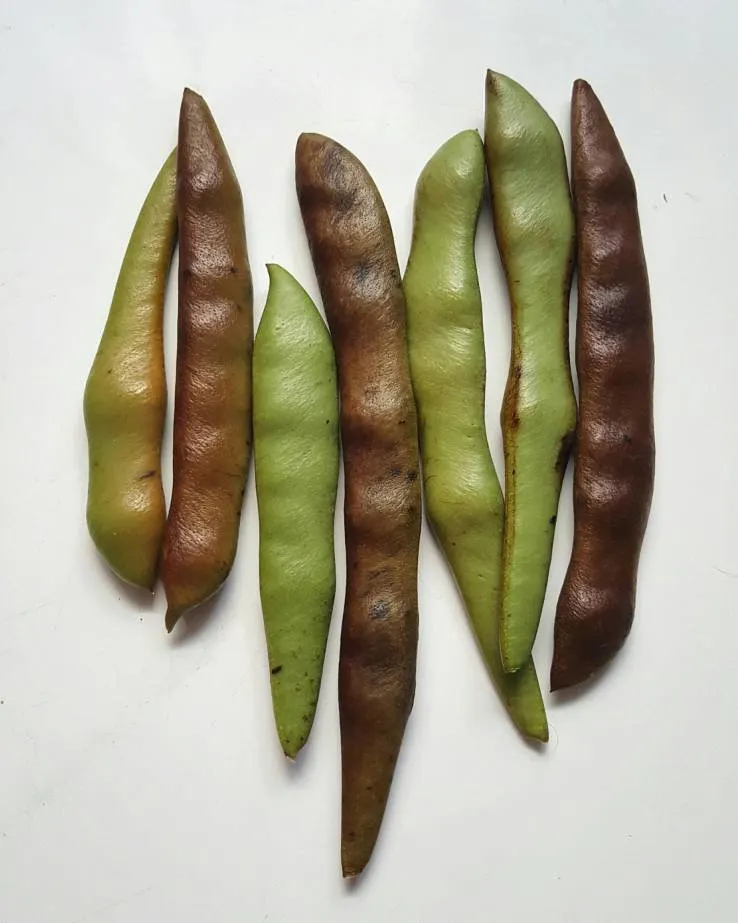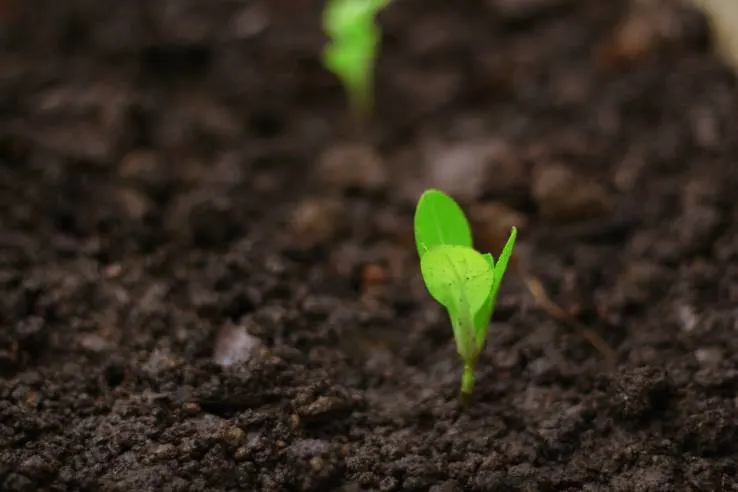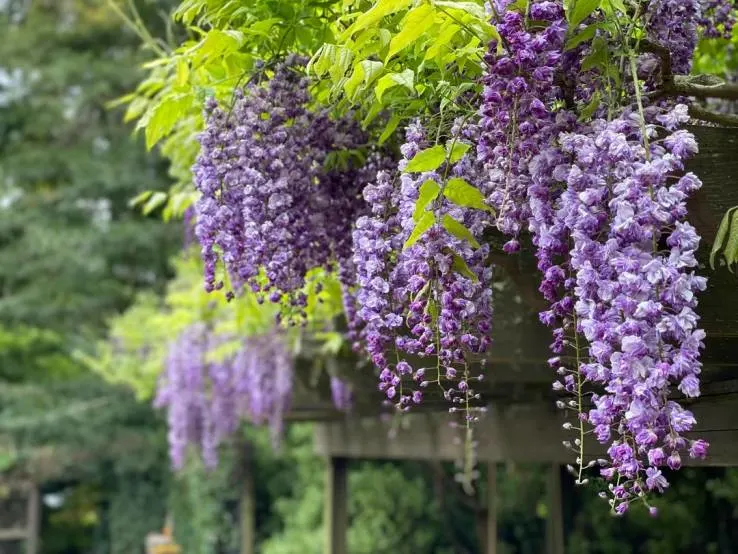Wisteria, known for its striking colorful flowers and irresistible charm, holds a special place in the hearts of many.
But beyond its beautiful flowers, another exciting factor regarding this botanical marvel lies along its graceful vines.
Want to know what it is?
You guessed it right—Wisteria seed pods! Possessing a delicate and charming quality, like nature’s hidden gems. These amazing seed pods hold the promise of new life, encapsulating the beauty and strength of the Wisteria plant.
In this article, we will explore the complete detail of growing and harvesting Wisteria seed pods.
So, let’s unveil the exciting facts about nature and discover some captivating wonders!
- Wisteria Seed Pods!
- Life Cycle of Wisteria Seed Pods!
- Factors Affecting Wisteria Seed Pod Development!
- Can We Grow Wisteria from Seed?
- Harvesting Wisteria Seed Pods!
- Growing Wisteria from Seed!
- When Should You Plant Wisteria Seeds?
- Wisteria Seed Pods | Challenges and Solutions!
- Should I Remove Wisteria Seed Pods?
- Wisteria Seed Pods | Precautions and Considerations!
- Conclusion!

Wisteria Seed Pods!
Wisteria seed pods possess a unique appearance that differentiates them from other botanical structures.
These elongated pods can range in size, typically between 5 to 10 cm in length, depending on the Wisteria species.
Unlike the size, the color of these pods varies depending on different varieties and stages of development (we will discuss this later).
Initially, these pods emerge as green or pale green, seamlessly blending with the surrounding foliage.
But as they mature, they gradually transform from green to deeper brown.
Getting my point?
Green or brown, the Wisteria seed pods resemble large beans or pea pods, but they are not edible.
In fact, these pods are considered the most poisonous part of the plant.
So, you should never allow children or pets to eat any part of the Wisteria plants, especially the seeds.
Life Cycle of Wisteria Seed Pods!
The life cycle of Wisteria seed pods is an interesting journey involving several stages of growth and maturation.
It all begins with the pollination of Wisteria flowers, typically achieved through the action of insects.
Once the flowers are successfully pollinated, they gradually droop and give way to the development of seed pods.
Initially, the developing seed pods emerge as small, elongated structures within the fading blossoms.
Over time, these pods undergo significant growth and expand their size.
As the pods mature, they develop a hard texture and slightly wrinkled appearance.
This transformation signifies that the seeds within are progressing toward their full maturity.
Upon reaching maturity, the pods begin to dry out.
The green color fades, and the pods adopt a more distinct brown or tan hue, as mentioned before.
This drying process is a natural indication that the seeds within the pods are ready for dispersal.
Once fully dried, the pods will eventually split and distribute their seeds in nature.

Factors Affecting Wisteria Seed Pod Development!
The development of Wisteria seed pods is influenced by some common factors, including:
Environmental conditions (sunlight, moisture)
The health of the Wisteria plants
Let’s talk about these factors in detail:
Adequate sunlight is essential for the plant’s overall growth and reproductive processes, including seed pod development. Wisteria thrives in full sun or partial shade, and insufficient light may hinder the formation and maturation of seed pods.
Proper moisture levels in the soil is also vital for optimal seed pod development. While Wisteria is generally drought-tolerant, excessive dryness or waterlogged conditions can negatively impact the plant’s health.
The health of the Wisteria plant plays a significant role in seed pod development. A strong and well-nourished Wisteria plant is more likely to produce healthy seed pods than an immature one.
Note: Adequate fertilization, pruning, and regular maintenance practices contribute to the plant’s health and, subsequently, to the development of high-quality seed pods.
Can We Grow Wisteria from Seed?
In short, the answer is YES! But it isn’t suggestible to do so.
Let me tell you why.
Though you can grow new Wisteria from the seeds, it is not the best way to propagate this plant.
The reason is that the Wisteria you buy from your local nursery is usually grafted, and the seeds they produce aren’t intended for growing new Wisteria vines.
Therefore, there is a possibility that the plant you grow from seed might appear as a different variety, far different from its parent plant.
Getting my point?
The other thing to keep in mind while growing Wisteria from the seeds is that it takes a long time to mature.
Typically, it takes about 15 to 20 years for Wisteria to grow from seed and produce blooms.
Can you wait for all these years?
Listen! Even if you have a good tolerance power, you have to remember that there is no guarantee that the Wisteria plant growing from the seed will bloom.
Therefore, you can go with much better options for the propagation of Wisteria plants, like:
Cutting
Air layering
These methods are preferable, and there are increased chances of success in using them.
Harvesting Wisteria Seed Pods!
If you still prefer to grow Wisteria from seed, you must start by collecting some fresh seeds.
To do so, it is best to harvest the seed pods before they explode.
If not, you have to hunt on the ground for individual seeds.
But how would you know the seed pods are ready to collect?
Listen! The best time for harvesting can be determined by observing specific maturity signs.
As the seed pods mature, they typically change color and become noticeably drier and more brittle.
The initial green color fades, giving way to shades of brown or tan.
To test the maturity of the seed pods, gently squeeze a few Wisteria pods between your fingers. If they feel firm and show resistance to pressure, it indicates that they are not fully matured.
On the other hand, if the pods feel slightly wrinkled and easily break apart, it is a sign that they are ready for harvesting.
When you collect your seed pods, store them in a closed container or paper bag so that when the pods explode, the seeds will remain within the container.
Growing Wisteria from Seed!
There are significantly lower chances of success in growing Wisteria from seeds, but with the right technique, you can increase the chances in this challenging battle.
In the start, gather fresh Wisteria seeds from mature seed pods. Harvest the Wisteria pods when they turn brown and start to dry out.
Pro Tip: It is best to wait until fall to gather the seeds.
When you are sure the pods are completely dry, twist them to release the Wisteria seeds.
After getting the seeds, you have to follow these simple steps:
Soak the Wisteria seeds in warm water a night before planting. When you soak Wisteria seeds in warm water, it softens the seed coat and promotes successful sprouting.
Fill small seed pots or seed trays with a well-draining potting mix.
Plant the seeds about an inch deep into the soil. While you plant the seeds, make sure to space them adequately.
Moisten the soil gently with water, ensuring that the soil remains consistently damp but not soggy.
Place the pots in warm, sunny spots where they receive at least six hours of sunlight daily. Wisteria thrives in full sun, which is essential for healthy growth.
Keep the soil consistently moist, and then you can expect germination within a few weeks.
When Wisteria seedlings develop several sets of true leaves, you can transplant them into larger individual pots or directly into the garden.
Simple, isn’t it?
Now let’s move toward the next segment in order to gain a clear understanding of the best timing to plant these seeds.
When Should You Plant Wisteria Seeds?
In the fall, you can plant Wisteria seeds indoors and take care of your plants inside over the winter.
You can also sow the seeds directly in the ground, but they won’t germinate until spring.
Therefore, there is no need to worry if you already choose to plant the seeds outdoors during the fall.
But planting Wisteria seeds outside isn’t that simple.
Indoor-grown Wisteria seedlings can be planted outside in spring or summer only if grown up to 4-5 inches tall.
When planting, you must also ensure the last frost date has passed, and the soil has warmed up.
Wisteria Seed Pods | Challenges and Solutions!
So far, you have learned how you can grow Wisteria from seeds.
However, it is crucial to address the potential challenges you may face during the growth and harvesting phase to obtain a complete understanding.
Let’s discuss all these problems and their solutions in detail.
Premature Splitting
Some Wisteria pods may split prematurely before reaching full maturity.
It occurs due to fluctuations in moisture levels, extreme temperature changes, or physical disturbances.
To prevent premature splitting, ensure that your Wisteria receives consistent moisture and avoid rough handling of the seed pods.
Low Seed Viability
Wisteria seeds may experience varying levels of viability, affecting their ability to germinate successfully.
Factors contribute to reducing the seed viability, including:
Age
Storage conditions
Genetic variations
To improve germination rates, select fresh seeds and follow proper storage methods to maintain their viability.
Inconsistent Germination
Germination rates may vary among Wisteria seeds, even under ideal conditions.
Some Wisteria seeds may exhibit delayed germination or fail to sprout altogether.
Patience is essential when working with Wisteria seeds, as germination can sometimes take several weeks or even months.

Pest and Disease Management Strategies
While Wisteria seed pods are relatively resistant to pests and diseases, still certain issues can arise.
Implementing effective pest and disease management strategies can help maintain the quality of the seed pods.
Let me tell you about some common pests of Wisteria plants.
Aphids and Scale Insects
These sap-sucking pests can infest Wisteria plants, including the seed pods.
Regularly inspect the plants for signs of infestation, such as sticky residue or tiny crawling insects.
Control measures may include:
Physical removal
Insecticidal soaps
Horticultural oils
Make sure to apply all the stuff according to the manufacturer’s instructions.
Powdery Mildew
Wisteria plant is also susceptible to powdery mildew, a fungal disease that manifests as a white, powdery growth on
Leaves
Stems
Seed pods
To minimize the risk, ensure proper air circulation around the plant and avoid overhead watering.
If powdery mildew appears, prune affected plant parts and apply fungicides as recommended.
Related Article: Wisteria vs. Lilac – Same but Different!
Should I Remove Wisteria Seed Pods?
The decision is all yours!
The choice to remove Wisteria seed pods depends on your specific goals and preferences regarding the Wisteria plant.
On the one hand, the seed pods can add visual interest to the plant, and you can save a lot of your time by not removing them.
Because of this reason, many gardeners appreciate the unique beauty that the seed pods bring to their wisteria vines, so they choose to leave them intact for decorative purposes.
Contrarily, there are practical considerations for removing Wisteria seed pods.
What’s that?
Listen! The plant’s energy is directed toward producing seeds within the pods.
Therefore, removing the seed pods is essential if you want to encourage more vigorous growth and better flowering.
As it redirects the energy toward other parts of the plant.
Doing so redirects the energy toward other parts of the plant.
Thus, ultimately focuses on producing new plant foliage and developing stronger roots which can result in healthier and more abundant blooms.

So, assess your priorities for your Wisteria plant and determine whether you value the decorative aspect of the pods or prioritize channeling the plant’s energy into other areas.
NOTE: Keep in mind that removing the Wisteria pods will not guarantee immediate or significant changes in flowering behavior.
Wisteria Seed Pods | Precautions and Considerations!
When handling Wisteria seed pods, it is essential to ensure personal safety and preservation of the pods.
For this purpose, you have to keep certain precautions and considerations in mind.
These include:
Skin Protection: Wisteria sap cause skin irritation in some individuals. It is advisable to wear gloves or use barrier creams when handling Wisteria pods, especially for those with sensitive skin.
Eye Protection: While working with these pods, be cautious not to touch your eyes with sap-covered hands. If contact occurs, rinse the eyes with clean water and seek medical attention if irritation persists.
Avoid Ingestion: Wisteria seeds and pods are not intended for consumption and can be toxic if ingested. Keep them out of reach of children and pets.
Ethical Harvesting: When collecting seed pods from Wisteria plants in public spaces or gardens, always obtain permission from the relevant authorities or property owners. Respect the natural environment and the rights of others while enjoying the beauty of Wisteria seed pods.
These precautions ensure a safe and responsible approach to handling Wisteria pods. Thus, minimizing the risk and maximizing enjoyment throughout the process.
That’s all!
Now it’s time to move toward the conclusion and summarize the talk here.
Conclusion!
Wisteria seed pods have a short life span depending on different environmental factors and the plant’s health.
Wisteria pods usually split and spread their seeds when they become mature (change color from green to brown or tan).
There are different methods to grow the Wisteria plant, but growing Wisteria from the seeds is the most common, though there are fewer chances of success. To increase the chances of success in propagating Wisteria from the seeds, you have to carefully follow every single step and also don’t forget to check the right time to plant the seeds.
Also, keep in mind that the Wisteria seed pods are toxic in nature, so be careful while dealing with them.
You can remove them if you want, but if you love their aesthetic appeal, let them hang on your tree.
I hope this post helps you a lot.
If you like this post, help us spread the wonders of Wisteria by sharing this article with your friends.
Best Regards,
Moiz Atiq.
